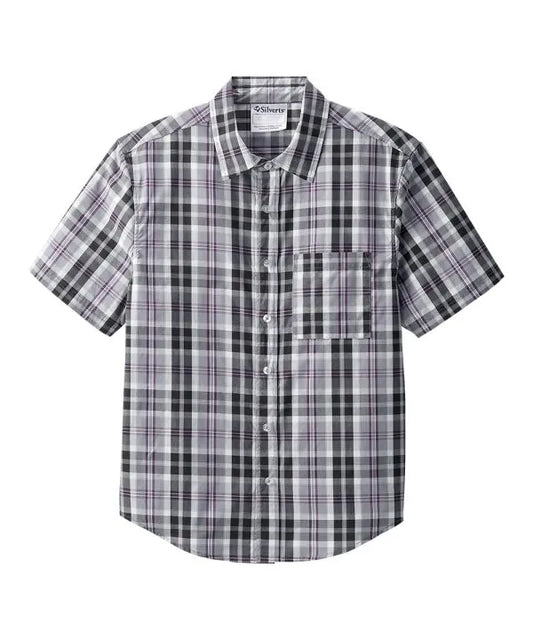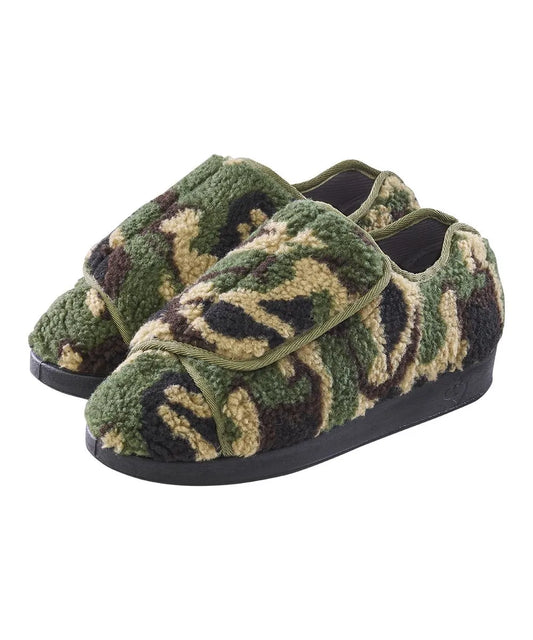Written by Tara Chen & reviewed by Nicole Fernandes
Parkinson’s disease is a neurodegenerative disorder that affects millions of individuals around the world. It impacts the region of the brain, called the basal ganglia, that controls body movements, and often results in difficulties with walking, maintaining balance, and moving. It also causes tremors, stiffness, poor posture, and more. One of the common challenges faced by individuals with Parkinson's is difficulty in dressing independently due to motor impairments and reduced dexterity.
However, adaptive clothing options have provided solutions to make dressing easier and more comfortable for patients with Parkinson’s. In this blog post, we will explore several clothing solutions that address the unique needs of patients with Parkinson’s, which will help them maintain their independence and freedom.
1. Choose clothing with comfortable fabrics
Parkinson’s disease causes issues with movement such as stiffness and rigidity, which makes dressing a difficult task. By choosing clothes with comfortable fabrics, there can be a greater range of motion and less discomfort for those with Parkinson’s. Fabric that is soft and breathable also reduces irritation on the skin and promotes healthy skin. Also, stretchy fabrics, such as pants with elastic waistbands, allow the individual with Parkinson’s to have more flexibility in their movements and it also accommodates changes in body size.
Clothing composed of natural fibres, such as cotton and bamboo, provides breathability to the wearer and is gentle on the skin. Avoid rough fabrics that feel scratchy on the skin, as they will cause irritation and discomfort in the long run. Additionally, fabrics that are moisture-wicking are an excellent investment. Individuals with Parkinson’s tend to have difficulties regulating their body temperature, and moisture-wicking fabrics can manage perspiration. They are able to pull moisture away from the body, keeping the wearer cool and dry. It also reduces any discomfort that may be caused by sweating. By prioritizing the selection of appropriate fabrics, individuals with Parkinson’s can improve their overall comfort and well-being.
2. Magnetic closures
Many clothing items have button closures that require fine motor movements to fasten, which can be difficult for those with Parkinson’s. An adaptive clothing feature is to have magnetic closures, instead of buttons, to fasten clothing items. The magnets are usually discretely embedded in the fabric, and are just as secure, if not stronger, than traditional buttons. It can be used in shirts, jackets, and pants, and allows individuals with Parkinson’s to easily put on and take off their clothing items.
For example, June Adaptive offers Men’s Long Sleeve shirts with Magnetic Buttons in four sizes and two patterns. It is lightweight and made of 100% Oxford cotton for a comfortable fit.

3. Front-closure bras
Bras tend to have metal hook closures at the back that can be difficult to fasten and require complex hand movements, and arm flexibility. Fortunately, adaptive bras have hook closures at the front that are easier to reach and fasten. This makes it easier for individuals with Parkinson’s to fasten and decreases their time dressing time in the morning. Additionally, instead of hook closures, some front-closure bras may also offer a simple snap button or magnetic closure that requires minimal effort. Overall, front-closure bras provide convenience, allowing women with Parkinson's to dress independently and undress with ease.
For example, June Adaptive offers Women’s Front Closure Bras in five sizes. It only has three metal hooks in the front and is made of breathable fabric.

4. Elastic waistbands
Pants tend to have zippers and buttons that can be complex to fasten and require fine motor movements. This can be frustrating for those with Parkinson’s to fasten and take a lot of time in the dressing routine. Moreover, Parkinson's can cause fluctuations in body size and involuntary movements, making regular waistbands uncomfortable and challenging to manage. Fortunately, elastic waistbands offer a practical solution by providing flexibility and adjustability. Whether incorporated into pants, skirts, or shorts, elastic waistbands allow for easy dressing and accommodate changes in waist size. They provide a comfortable fit without restricting movement or causing discomfort, allowing individuals with Parkinson's to feel at ease throughout the day.
For example, June Adaptive offers Women’s Pants with Easy Grip Pull in six sizes and two colours. It features an elastic waistband, soft fabric, pull-up bands, and an adjustable hem for ease of use and comfort.

5. Adaptive socks
Individuals with Parkinson's may struggle with maintaining balance and preventing falls, making the choice of socks crucial. Adaptive socks are designed with non-slip grips on the soles to address these concerns. This enhances stability and reduces the risk of slipping on smooth surfaces. Seamless designs are also available, which minimizes the risk of rubbing or irritation.
Adaptive socks are also usually made of soft and breathable fabrics that provide comfort and prevent moisture build-up. By wearing adaptive socks, individuals with Parkinson's can maintain balance, improve safety, and enhance overall comfort.
6. Slip-ons and elastic shoes
Tying shoelaces can be a frustrating and time-consuming task for individuals with Parkinson's due to limited dexterity and fine motor control. Adaptive shoes feature elastic shoelaces or slip-on shoes, which are a practical alternative. Elastic shoelaces transform shoes with laces into a slip-on, which eliminates the need for tying and untying. They allow for a snug fit while providing the flexibility to easily slip the shoes on and off. Moreover, slip-on shoes require no lacing at all and can be effortlessly worn or removed. These options provide convenience and reduce the risk of falls that may occur while attempting to tie shoelaces.
7. Layer for temperature regulation
Parkinson's disease can affect body temperature regulation, causing individuals to feel excessively hot or cold. Layering clothes allow for easy adjustment to changing temperatures. Consider wearing lightweight base layers that are moisture-wicking, which keeps the body dry and comfortable. Also try to opt for fabrics that are breathable, such as those made of bamboo, merino wool, cotton, and linen. In addition, some fabrics have innovative temperature-regulating technology that features built-in cooling or healing elements to automatically regulate the wearer’s body temperature.
After the lightweight base layer, consider wearing something insulating, such as fleece or wool, that can provide warmth if needed. Lastly, a lightweight outer layer can be worn to protect against rain, wind, or extreme temperatures. Opt for garments that can be easily removed or added depending on the temperature. Try to look for ones with accessible closures, like snaps or magnetic buttons. Overall, layering allows individuals with Parkinson's to easily adjust their clothing to stay comfortable and prevent overheating or feeling too cold.
8. Use dressing aids and assistive devices
Dressing aids and assistive devices can greatly assist individuals with Parkinson's in putting on and taking off their clothes. These devices enhance independence and make dressing easier. For instance, there are dressing sticks and hooks that help with pulling up garments and reaching zippers or buttons. It also assists with other dressing tasks that may be challenging due to limited mobility or tremors. Moreover, button hooks and zipper pulls provide added leverage and grip for manipulating buttons and zippers.
These tools can reduce motor-associated pain and make dressing time-consuming. In addition, reacher and grabber tools can assist in getting clothing items from high shelves or picking up dropped garments, without the need for bending or excessive reaching.
Additionally, wearing socks and shoes often requires bending over and flexibility of the limbs. Sock aids can help individuals with Parkinson’s put on socks without having to bend down or strain. These aids typically consist of a flexible frame with handles and a fabric sleeve that holds the sock in place. On the other hand, shoe horns make it easy for the wearer to slip shoes onto the feet by maintaining the shoe's shape and providing a smooth surface for the foot to slide into. Long-handled shoe horns are especially helpful to use and convenient. Overall, by using these dressing aids, individuals with Parkinson's can overcome specific challenges and enhance their dressing experience.
9. Maintain a safe dressing environment
Creating a safe dressing environment is essential for individuals with Parkinson's to reduce the risk of falls and accidents. It is important to ensure that the dressing area is well-lit to help individuals see and navigate their surroundings effectively. Adequate lighting also minimizes the risk of tripping over objects or misjudging distances. Additionally, it is important to keep the dressing area free of clutter and remove any potential tripping hazards, such as loose rugs or obstacles on the floor.
Try to secure rugs with non-slip backing or remove them altogether if it continues to be an issue. Also, maintain clear pathways in the room for walking to make movement and dressing easier. In addition, avoiding the purchase of loose and long hemlines can reduce the chance of accidentally stepping on the garment, tripping and falling. By purchasing clothes with shorter hemlines, individuals with Parkinson's can reduce the risk of accidents and enhance their overall dressing experience.
Living with Parkinson's disease presents unique motor challenges, but with the right clothing choices and adaptations, individuals can maintain their independence and style. Prioritizing comfort, ease of dressing, and safety can greatly enhance the dressing experience for individuals with Parkinson's, promoting confidence and well-being.
Remember to consult with healthcare professionals and explore adaptive clothing options to find solutions that best suit your individual needs and preferences. By implementing these clothing tips, individuals with Parkinson's can navigate their daily routines with greater ease, maintain their independence, and continue to express their personal style.















